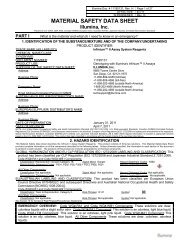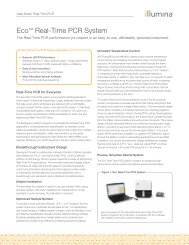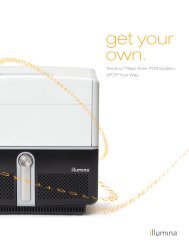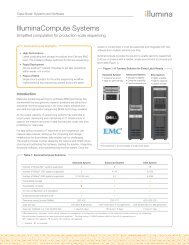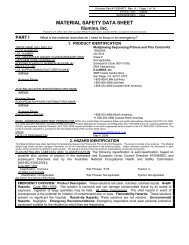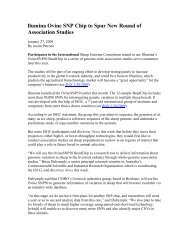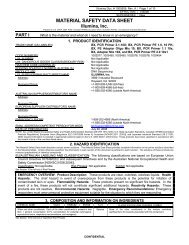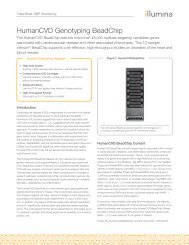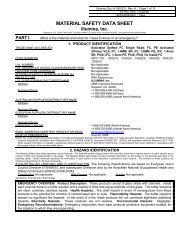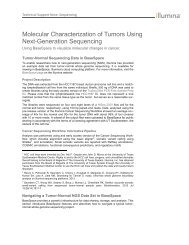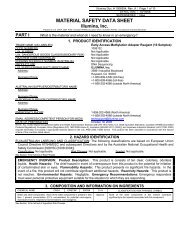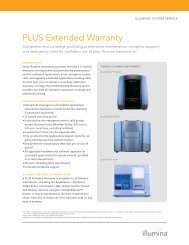G - Illumina
G - Illumina
G - Illumina
Create successful ePaper yourself
Turn your PDF publications into a flip-book with our unique Google optimized e-Paper software.
Pharmacogenetics of Severe Adverse Drug Reaction<br />
Colin Ross, PhD<br />
Medical Genetics<br />
CMMT, CFRI, UBC
Paradox of Modern Drug Development<br />
1. Clinical trials provide evidence of efficacy<br />
and safety at usual doses in populations<br />
+ =<br />
Safe & Effective<br />
2. Physicians treat individual patients who can<br />
vary widely in their response to drug therapy<br />
Safe & Effective<br />
+ =<br />
No Response<br />
Adverse Drug Reaction
Adverse Drug Reactions<br />
5 th leading cause of death in the USA<br />
Over 100,000 fatal ADRs in hospitalized patients each year<br />
Over 2,000,000 serious ADRs in hospitalized patients (6.7%)/yr<br />
ADRs cause 7% of all hospital admissions (UK)<br />
ADR Health care costs: $78-177 billion annually (USA)<br />
Exceeds the annual cost of medications<br />
ADRs cause an average 2 day increase in hospital stays<br />
95% of all ADRs are unreported
June 3, 2008<br />
“12% of patients rushed to<br />
Vancouver General Hospital<br />
have adverse reactions to<br />
medications.”<br />
Zed et al, Can Med Assoc J, 2008<br />
June 5, 2008
50% of newly approved therapeutic health<br />
products have serious ADRs, discovered<br />
only after the product is on the market<br />
(Health Canada, 2007)
ADRs in Children
Increased Risk of Severe e e<br />
ADRs in Children<br />
11-15% of hospitalized children have an ADR 1-3<br />
ADRs cause 22% of admissions i in pediatric i cancer<br />
patients 4<br />
30% of ADRs in hospitalized children are severe causing<br />
long-term disability or death 4<br />
26,000 children die each year from ADRs in USA 5<br />
Gross lack of knowledge about ADRs in children<br />
1. Gonzalez-Martin et al. Int J Clin Pharmacol Ther 1998<br />
2. Martinez-Mir et al., Br J Clin Pharmacol, 1999<br />
3. Takata et al, Pediatrics, 2008<br />
4. Mitchell et al., Pediatrics, 1988<br />
5. Lazarou et al, JAMA, 1998
We Can’t Treat Children Like Adults<br />
Increased Risk of Severe<br />
ADRs in Children<br />
>75% of approved drugs used<br />
in children are untested in<br />
pediatric populations<br />
Young children cannot<br />
evaluate or express their own<br />
response to medications<br />
Pediatric dosage forms not<br />
available<br />
Children metabolize drugs<br />
differently than adults
Factors Contributing to<br />
Variability in Drug Response<br />
Gender<br />
Ethnicity<br />
Diet<br />
Compliance<br />
Concomitant Disease<br />
Concomitant Drugs<br />
Age<br />
Weight<br />
Genetic Factors<br />
20-95%<br />
Patient genotype is currently an unknown<br />
factor in the prescribing of medicines<br />
i
How Can The Causes of<br />
Variability be Unraveled?
The Canadian Pharmacogenomics<br />
Network for Drug Safety<br />
Hypothesis<br />
Genetic polymorphisms in drug metabolism genes<br />
underlie a significant portion of concentrationdependent<br />
ADRs in children.<br />
Goal<br />
To develop genotype-based dosing guidelines to<br />
predict safety and avoid severe ADRs in children.
Goal is to predict safety and avoid potential<br />
complications, not to make effective drugs<br />
difficult to obtain for patients
ADR Surveillance
Over 95% of ADRs are not reported<br />
2 studies identified patients<br />
being treated for drug-<br />
induced T.E.N. in burn units<br />
Q: What % of these ADRs<br />
were reported ?<br />
4% ADR Reporting Mittman et al., Drug Safety 2004;27(7):477-87.<br />
2.5% ADR Reporting Rzany et al., J Clin Epidemiol 1996;49(7):769-73
Canadian<br />
Pharmacogenomics Network<br />
for Drug Safety<br />
CPNDS Active Surveillance Site<br />
Canadian Pediatric Surveillance<br />
C17 Pediatric Oncology Sites<br />
EDMONTON<br />
Stollery<br />
Children's<br />
Hospital<br />
MONTREAL<br />
Sainte-<br />
Justine<br />
Hospital<br />
HALIFAX<br />
IWK Grace<br />
Health Centre<br />
VANCOUVER<br />
Children’s & Family<br />
Research Institute &<br />
B.C. Children’s<br />
Hospital<br />
CALGARY<br />
Alberta<br />
Children’s<br />
Hospital<br />
WINNIPEG<br />
Winnipeg<br />
Children’s<br />
Hospital<br />
LONDON<br />
Children’s<br />
Hospital of<br />
Western<br />
Ontario<br />
OTTAWA<br />
Children’s Hospital of Eastern Ontario<br />
TORONTO<br />
Hospital for Sick Children<br />
HAMILTON<br />
Children’s Hospital
Recruitment of ADR Cases<br />
and Drug-Matched Controls
Genomic Analyses
Association Study<br />
Patients with Disease<br />
ACGTATATATTT<br />
ATATTTAAAGGGCGTGTG<br />
AAGGGCGTGTGGACGTGACGTACACACAGAACTATT<br />
ACGTGACGTACACACAGAACTATT<br />
ACGTAGATATTTAAAGGGCGTGTGCACGTGACGTACACACAGTACTTTT<br />
ACGTATATATTTGAAGGGCGTGTGGACGTGACGTACACACAGTACTATTACTATT<br />
ACGTAGATATTTAAAGGGCGTGTGCACGTGACGTACACACAGAACTTTTTT<br />
ACGTAGATATTTAAAGGGCGTGTGGACGTGACGTACACACAGTACTTTT<br />
ACGTAGATATTTGAAGGGCGTGTGGACGTGACGTACACACAG<br />
ACGTGACGTACACACAGTACT<br />
ACTTTT<br />
ACGTATATATTTAAAGGGCGTGTGCACGTGACGTACACACAGTACTTTT<br />
ACGTAGATATTTGAAGGGCGTGTGGACGTGACGTACACACAGAACTATTACGTGACGTACACACAGAACTATT<br />
ACGTATATATTTAAAGGGCGTGTGGACGTGACGTACACACAGTACTTTT<br />
Control Unaffected Patients<br />
ACGTATATATTTAAAGGGCGTGTGGACGTGACGTACACACAGAACTTTTTT<br />
ACGTAGATATTTGAAGGGCGTGTGCACGTGACGTACACACAGAACTATT<br />
ACGTATATATTTAAAGGGCGTGTGGACGTGACGTACACACAGAACTTTTTT<br />
ACGTAGATATTTAAAGGGCGTGTGGACGTGACGTACACACAGAACTTTTTT<br />
ACGTATATATTTGAAGGGCGTGTGCACGTGACGTACACACAGAACTTTTTT<br />
ACGTAGATATTTAAAGGGCGTGTGGACGTGACGTACACACAGAACTATTACGTGACGTACACACAGAACTATT<br />
ACGTATATATTTGAAGGGCGTGTGCACGTGACGTACACACAGTACTTTT<br />
ACGTATATATTTAAAGGGCGTGTGGACGTGACGTACACACAGAACTATTACGTGACGTACACACAGAACTATT<br />
ACGTAGATATTTGAAGGGCGTGTGCACGTGACGTACACACAGAACTTTTTT
Association Study<br />
Patients with Disease<br />
ACGTATATATTT<br />
ATATTTAAAGGGCGTGTG<br />
AAGGGCGTGTGGACGTGACGTACACACAGAACTATT<br />
ACGTGACGTACACACAGAACTATT<br />
ACGTAGATATTTAAAGGGCGTGTGCACGTGACGTACACACAGTACTTTT<br />
ACGTATATATTTGAAGGGCGTGTGGACGTGACGTACACACAGTACTATTACTATT<br />
ACGTAGATATTTAAAGGGCGTGTGCACGTGACGTACACACAGAACTTTTTT<br />
ACGTAGATATTTAAAGGGCGTGTGGACGTGACGTACACACAGTACTTTT<br />
ACGTAGATATTTGAAGGGCGTGTGGACGTGACGTACACACAG<br />
ACGTGACGTACACACAGTACT<br />
ACTTTT<br />
ACGTATATATTTAAAGGGCGTGTGCACGTGACGTACACACAGTACTTTT<br />
ACGTAGATATTTGAAGGGCGTGTGGACGTGACGTACACACAGAACTATTACGTGACGTACACACAGAACTATT<br />
ACGTATATATTTAAAGGGCGTGTGGACGTGACGTACACACAGTACTTTT<br />
Control Unaffected Patients<br />
ACGTATATATTTAAAGGGCGTGTGGACGTGACGTACACACAGAACTTTTTT<br />
ACGTAGATATTTGAAGGGCGTGTGCACGTGACGTACACACAGAACTATT<br />
ACGTATATATTTAAAGGGCGTGTGGACGTGACGTACACACAGAACTTTTTT<br />
ACGTAGATATTTAAAGGGCGTGTGGACGTGACGTACACACAGAACTTTTTT<br />
ACGTATATATTTGAAGGGCGTGTGCACGTGACGTACACACAGAACTTTTTT<br />
ACGTAGATATTTAAAGGGCGTGTGGACGTGACGTACACACAGAACTATTACGTGACGTACACACAGAACTATT<br />
ACGTATATATTTGAAGGGCGTGTGCACGTGACGTACACACAGTACTTTT<br />
ACGTATATATTTAAAGGGCGTGTGGACGTGACGTACACACAGAACTATTACGTGACGTACACACAGAACTATT<br />
ACGTAGATATTTGAAGGGCGTGTGCACGTGACGTACACACAGAACTTTTTT<br />
Odds Ratio = 16<br />
P value = 0.02
Genome Canada’s GATC Project supported the<br />
acquisition of the <strong>Illumina</strong> 500GX platform at the<br />
CMMT<br />
Centre for Molecular Medicine & Therapeutics<br />
Vancouver, B.C.
ADME/Tox Genes SNP Arrays<br />
<strong>Illumina</strong> Sentrix<br />
Array Matrix<br />
Gene Classification<br />
Phase I Metabolizing Enzymes<br />
Phase II Metabolizing Enzymes<br />
Receptors / Drug Targets<br />
Transporters<br />
Transcription factors<br />
Immunity<br />
Ion Channels<br />
Others<br />
Examples<br />
CYP1A1, CYP2B6, ALDH2<br />
UGT2B7, GSTM1, NAT1, COMT<br />
VDR, PPARG, CETP<br />
ABCB1, ABCC1, ABCC2<br />
HNF4A, STAT3, NR1I2<br />
HLA variants<br />
SCN5A, KCNH2, KCNQ1<br />
EPHX1, FMO1, PTGS1<br />
Current: 3072 SNP array<br />
Other options:<br />
6144 to 1.1 million SNP arrays<br />
1536 HapMap derived<br />
haplotype tag SNPs<br />
1536 Altered enzyme activity<br />
common non-synonymous,<br />
literature validated rare nonsynonymous,<br />
synonymous<br />
coding SNPs
SNP Genotyping<br />
DNA<br />
(blood,<br />
saliva,<br />
buccal)<br />
DNA Purification Robots<br />
2D Laser Etched<br />
Bar-coded Samples<br />
Long Term<br />
Storage -80<br />
o C<br />
<strong>Illumina</strong><br />
BeadXpress<br />
1-384 tests<br />
per sample<br />
<strong>Illumina</strong><br />
BeadStation<br />
384-1.2 million<br />
test per sample
<strong>Illumina</strong> SNP Genotyping<br />
20 million beads on one slide
<strong>Illumina</strong> SNP Genotyping<br />
DNA target capture probe<br />
affixed to bead:<br />
Complementary to SNP<br />
region (50 bp)<br />
Bead<br />
Slide
<strong>Illumina</strong> SNP Genotyping<br />
Complementary DNA from<br />
patient DNA bound to probe<br />
[G]<br />
Bead<br />
Slide
<strong>Illumina</strong> SNP Genotyping<br />
Single-nucleotide nucleotide extension<br />
(biochemical reaction)<br />
[G] [G -C]<br />
Bead<br />
Slide
<strong>Illumina</strong> SNP Genotyping<br />
Single-nucleotide<br />
nucleotide<br />
product<br />
fluorescently<br />
labeled<br />
Individual<br />
with “T”<br />
genotype at<br />
this site<br />
[G] [G -C]<br />
[T - A]<br />
Bead<br />
Slide
<strong>Illumina</strong> SNP Genotyping<br />
1.2M Chip (1.2 million SNPs)<br />
2 Samples/Chip<br />
[T/T] [T/G] [G/G]
Examples of SNP Genotyping Formats<br />
1. Custom SNP Panels<br />
1 to 200,000 SNPs/assay<br />
2. Human Genome-wide SNP panels<br />
300,000 SNPs Genome-wide<br />
12 samples/chip<br />
Highly cost-effective<br />
660,000 000 SNPs Genome-wide<br />
1.2 Million SNPs Genome wide
Raw<br />
Fluorescence<br />
Intensity Data<br />
al<br />
n Signa<br />
Green<br />
SNP #1 (480 samples)<br />
AA<br />
AB<br />
Yellow<br />
Intermediate<br />
Signal<br />
BB<br />
Genotype Text<br />
Output<br />
SNP 1 AA<br />
SNP 2 TT<br />
SNP 3 GG<br />
SNP 4 GC<br />
Red Signal
Raw SNP Data (n = 480)
SNP assay conversion rates for tag SNPs: 90-96%<br />
High Genotype Call Rates: >99%<br />
High Reproducibility: >99.99%<br />
– 16 miscalls out of 178,860 genotype calls (58 patient DNA<br />
replicates)<br />
– 0 miscalls out of 50,688 genotype calls (16 control DNA<br />
replicates)
30 replicate<br />
assays for<br />
each SNP
<strong>Illumina</strong> BeadXpress (Veracode) SNP Genotyping<br />
• 384 samples x 384 SNPs<br />
• SNP Conversion Rate: 95.05% (368/384)<br />
(# of SNPs that could be assayed)<br />
• Average Call Rate: 99.32% (min. 93%, max. 99.7%)
<strong>Illumina</strong> BeadXpress (Veracode) SNP Genotyping<br />
• 384 samples x 384 SNPs<br />
• SNP Conversion Rate: 95.05% (368/384)<br />
(# of SNPs that could be assayed)<br />
• Average Call Rate: 99.32% (min. 93%, max. 99.7%)<br />
Average SNP: GenCall Score = 0.86<br />
Cartesian View<br />
Polar View
<strong>Illumina</strong> BeadXpress (Veracode) SNP Genotyping<br />
• 384 samples x 384 SNPs<br />
• SNP Conversion Rate: 95.05% (368/384)<br />
(# of SNPs that could be assayed)<br />
• Average Call Rate: 99.32% (min. 93%, max. 99.7%)<br />
Best SNP: GenCall Score = 0.969<br />
Cartesian View<br />
Polar View
<strong>Illumina</strong> BeadXpress (Veracode) SNP Genotyping<br />
• 384 samples x 384 SNPs<br />
• SNP Conversion Rate: 95.05% (368/384)<br />
(# of SNPs that could be assayed)<br />
• Average Call Rate: 99.32% (min. 93%, max. 99.7%)<br />
Worst SNP: GenCall Score = < 0.30<br />
Cartesian View<br />
Polar View
In Progress:<br />
CPNDS Priority ADR Targets<br />
Codeine-induced infant mortality<br />
Cisplatin-induced deafness<br />
Anthracycline-induced i d cardiotoxicity<br />
i it<br />
Life-threatening skin reactions<br />
Vincristine-induced neuropathy<br />
Statin-induced induced muscle damage<br />
Interferon-β toxicity<br />
Warfarin-induced i d bleeding/thrombosis<br />
b i
Codeine
The American Academy of Pediatrics<br />
i<br />
and major authoritative texts list codeine<br />
as compatible with breastfeeding<br />
– Briggs et al., 2005; Pediatrics, 2001
Codeine-Induced Adverse Reaction<br />
Case Report<br />
A new mother was given Tylenol #3 for obstetric pain relief<br />
Given a standard dose (60 mg every 12 hours)<br />
Mother complained of significant drowsiness<br />
Codeine dose cut in half (30 mg every 12 hours)<br />
Infant showed poor feeding<br />
Infant died on day 13 due to respiratory failure<br />
Follow-up Analysis:<br />
Maternal milk from last day of the baby’s life contained<br />
morphine at 10-20x higher levels than expected (87 ng/ml)<br />
Infant’s blood contained lethal levels of morphine (70 ng/ml)
Identified genetic variants associated with a lethal adverse<br />
reaction to codeine in newborns<br />
Mother’s Genotype:<br />
CYP2D6 gene duplication<br />
UGT2B7*2/*2<br />
Opioid<br />
activity in<br />
brain<br />
Outcome:<br />
• Accumulation of morphine in<br />
breast milk (10-20x more than normal)<br />
• Breast milk fed to infant<br />
• Infant died at 13 days of age<br />
• Lethal levels of morphine<br />
accumulated in the infant<br />
causing CNS depression,<br />
respiratory failure, and death<br />
Codeine<br />
CYP3A4<br />
Norcodeine<br />
CYP2D6<br />
Morphine<br />
UGT2B7<br />
UGT1A1<br />
UGT2B7<br />
Codeine<br />
6-glucuronide<br />
Morphine<br />
Norcodeine<br />
6-glucoronide<br />
Liver<br />
Morphine<br />
3-glucuronide<br />
Morphine<br />
6-glucuronide<br />
Kidney
Completed Codeine Case-Control Validation Study<br />
Aug. 20, 2008
FDA drug label change and<br />
public health advisories<br />
Health Canada<br />
Public Advisory<br />
May 10, 2006<br />
Aug. 21, 2008<br />
Aug 17, 2007<br />
Estimated 1846 newborn infants<br />
are at risk for this codeine ADR<br />
each year in Canada<br />
(340,000 births, 73% breastfed, 52% mothers receive codeine<br />
post-childbirth,1.4% risk genotype)
Additional Cases of Infant Toxicity from<br />
Codeine from Literature<br />
35 reports of breastfeeding infants with<br />
ADRs to codeine, including:<br />
Unexplained severe drowsiness<br />
Apnea<br />
Bradycardia<br />
Cyanosis
Currently Performing Randomized Controlled Trial<br />
Prospective study to test the assess the benefit of a<br />
diagnostic test to prevent codeine ADRs in infants<br />
Study Design:<br />
600 women<br />
booked for<br />
elective<br />
C-section<br />
Prospective<br />
Screening for<br />
CYP2D6-UM<br />
Predictive<br />
Variants<br />
N = 300<br />
+ Test<br />
N = 12<br />
(est.)<br />
- Test<br />
N = 288<br />
(est.)<br />
Receive<br />
Ibuprofen or<br />
Naproxen<br />
post-partumpartum<br />
Standard Care:<br />
Receive<br />
codeine &<br />
monitoring for<br />
CNS depr. ADR<br />
Compare<br />
Outcomes<br />
Adverse events<br />
Adequate pain<br />
relief?<br />
Cost of ADRs<br />
Hospitalization<br />
Cost of care<br />
Cost of<br />
Screening<br />
Outcome of<br />
therapy/survival<br />
Treatment<br />
Compliance<br />
Validity of<br />
Diagnostic Test<br />
Control Group<br />
(standard care)<br />
N = 300<br />
Standard Care:<br />
Receive codeine &<br />
monitoring for CNS<br />
depression ADR<br />
Retrospective<br />
genetic screening<br />
for CYP2D6-UM
ADRs in Chemotherapy
Cancer Survival has Improved, but Survivors often<br />
Left with Lifelong Consequences of Severe ADRs<br />
April 10, 2008
Pediatric Oncology:<br />
1 in 750 young adults are survivors of childhood<br />
d<br />
cancer<br />
75% of cancer survivors suffered at least 1 ADR<br />
40% of cancer survivors have had a severe ADR<br />
(life-threatening, or disabling)<br />
25% of cancer survivors suffer 5 or more ADRs<br />
Geenan et al, JAMA, , 2007
Cisplatin-Induced Deafness
Cisplatin<br />
A highly effective anti-tumor tumor agent<br />
Treatment of solid tumours including ovarian, lung,<br />
bladder, head and neck<br />
In children: treatment of CNS tumors,<br />
hepatoblastoma, neuroblastoma, osteosarcoma<br />
>1,000,000 patients receive each year (N. America<br />
, , p y (<br />
& Europe)
Case Studies<br />
Case 1<br />
14 yrs old<br />
Osteosarcoma of<br />
Right proximal tibia<br />
Diagnosed Nov 2000<br />
Chemotherapy:<br />
– Cisplatin<br />
– Doxorubicin<br />
– Methotrexate<br />
Alive and Well<br />
Case 2<br />
12 yrs old<br />
Osteosarcoma of<br />
Right Proximal tibia<br />
Diagnosed Oct 1998<br />
Chemotherapy:<br />
– Cisplatin<br />
– Doxorubicin<br />
– Methotrexate<br />
Alive and Well<br />
OVERALL: Cases sound similar<br />
Same tumor, treatment, and cure outcomes
Case 2 Suffered Severe Hearing Loss<br />
Case 1 Case 2<br />
Normal Hearing Audiogram<br />
Severe Hearing Loss
Cisplatin-Induced Deafness<br />
Causes permanent<br />
cochlea<br />
hearing loss<br />
– Bilateral, l hair cell<br />
degeneration in cochlea<br />
– Initially high freq. loss<br />
(cells with higher<br />
metabolic activity)<br />
10-38% of adult patients affected<br />
Increased frequency and severity in children<br />
28-61%<br />
of children 5-14 develop severe hearing loss<br />
38-62%<br />
of children
Cisplatin-ADR Patient Recruitment<br />
162 pediatric patients with hepatoblastoma, brain tumor,<br />
germ cell tumours, neuroblastoma, osteosarcoma<br />
Controls<br />
ADR<br />
Cases<br />
Classification of Cisplatin ADR Cases and Controls<br />
Grade 0: Normal Hearing<br />
Hearing threshold of 20 dB or less (within normal range) at all<br />
frequencies<br />
Grade 1 Hearing Loss: Mild High Freq. Loss<br />
Minimum hearing threshold of 20-2525 dB (4000 Hz and above)<br />
Grade 2 Hearing Loss: Moderate High Freq. Loss<br />
May require speech therapy or intervention with hearing aid<br />
Minimum hearing threshold of 25-39 dB (4000 Hz and above)<br />
Grade 3 Hearing Loss: Severe Hearing Loss<br />
Requires intervention with hearing aid<br />
Minimum hearing threshold of 25-39 dB (2000 Hz and above)<br />
Grade 4 Hearing Loss: Deafness<br />
Requires intervention with cochlear implant<br />
Minimum hearing threshold of 40dB or more (1000Hz and above)<br />
n = 56<br />
n = 106
Multistage Approach<br />
Stage 1: Discovery<br />
Stage 2: Replication<br />
N = 55 Vancouver<br />
N = 107 Canada-wide<br />
P < 0.01<br />
P < 0.005<br />
Joel Hirschhorn & Mark Daly, Nature Reviews, , 2006
What Next?<br />
Patient Predicted to be at High Risk for<br />
Cisplatin-Induced Ototoxicity<br />
What is done now without a predictive test:<br />
Protocol Treatment Ototoxicity Intervention<br />
Osteosarcoma Doxorubicin & cisplatin Grade 2 Reduce cisplatin 50%<br />
Grade 3+<br />
Discontinue cisplatin<br />
Brain tumor Cisplatin, Etoposide, Grade 2 Reduce cisplatin 50%<br />
+ Vincristine Grade 3+ Discontinue cisplatin<br />
Osteosarcoma Doxorubicin + cisplatin Grade 3+ Discontinue cisplatin
What Next?<br />
Patient Predicted to be at High Risk for<br />
Cisplatin-Induced Ototoxicity<br />
Predictive testing:<br />
Alternative drug<br />
Increase monitoring in high risk patients<br />
e.g. patients in rural centres<br />
Experimental Protective Strategies to<br />
prevent cisplatin-ototoxicity<br />
t t i it<br />
• Sodium Thiosulfate<br />
• N-acetylcysteine<br />
D-methionine<br />
• Glutathione ethyl ester
In the Future<br />
Pharmacogenomics could have profound<br />
impact in medicine<br />
Advances in technology opening the<br />
doors to understanding the genetic factors<br />
of ADRs<br />
Whole Genome Sequencing<br />
Routine genotyping of millions of SNP variants<br />
Lower health care costs:<br />
ADRs now exceed the cost of medications in<br />
USA/Canada<br />
Improved safety<br />
Safer and More Effective Treatments
Canadian PGx Network for Drug Safety<br />
Pharmacogenomics: Michael Hayden, UBC<br />
Michael Phillips, Montreal<br />
Colin Ross, UBC<br />
Steven Leeder, Univ of Missouri<br />
ADR Surveillance: Bruce Carleton, UBC<br />
Gideon Koren, Univ Toronto<br />
Stuart MacLeod, UBC<br />
Doreen Matsui, UWO<br />
Audiology: Beth Brooks, BC Childrens<br />
Pediatric Oncology: Paul Rogers, BC Childrens<br />
Rod Rassekh, BC Childrens<br />
Pharmacokinetics: Michael Rieder, UWO<br />
David Freeman, UWO<br />
Data Analysis: Marie-Pierre Dube, Montreal<br />
Wyeth Wasserman, UBC<br />
Health-Economics: Craig Mitton, UBC<br />
Adrian Levy, UBC<br />
ADR Surveillance Investigators and Surveillors<br />
Vancouver: Claudette Hildebrand, Dan Wright<br />
Calgary: CheriNijssen-Jordan Jordan, David Johnson,<br />
Lina Verbeek, Rick Kaczowka,<br />
Edmonton: Corrine Sikora<br />
Winnipeg: Kevin Hall and Shanna Chan<br />
Toronto: Gideon Koren, Shinya Ito, Miho Inoue<br />
London: Michael Rieder and Becky Malkin<br />
Ottawa: Elaine Wong and Regis Vaillancourt<br />
Hamilton: Amy Cranston<br />
Montreal: Jean-Francois Bussières, Denis Lebel and Pierre Barret<br />
Halifax: Margaret Murray, Darlene Boliver and Carol-anne Osborne<br />
Funding Support<br />
• Genome Canada, Genome B.C.<br />
• CIHR<br />
• Canada Foundation for Innovation<br />
• Health Canada<br />
• BC Prov. Health Services Auth.<br />
• CDN Genetic Diseases Network<br />
• CDN Gene Cure Foundation<br />
• CDN C-17 Oncology Network<br />
• Pfizer<br />
• Eli Lilly<br />
• Merck-Frosst<br />
• Janssen Ortho<br />
• <strong>Illumina</strong> Inc.<br />
Students /Technicians<br />
Hagit Katzov Catherine Carter<br />
Parvaz Madadi Terry Pape<br />
Henk Visscher Fudan Miao<br />
Andrew Brown Graeme Honeyman<br />
Yannick Renaud



